Change grows slowly in America. It takes a long time for the change to reach a tipping point. But when it does reach a certain level, the change takes off. On the other hand, if change tries to happen too fast, it is fought off with resistance, anger, and envy. Is this the case with the Tucker Car Company? Or did the company implode under its own mismanagement?
Preston Tucker was a whiz kid. He rebuilt cars in his garage he had gotten out of a junkyard. As a young man, he worked with cars at the Indianapolis Motor Speedway in the 1930s. During World War II, Tucker attempted to build a plane, known as the “peashooter,” for the US, but problems within the company led to its failure. However, Tucker was successful in designing and building turrets for planes and other assorted vehicles. His combat car was turned down by the government because it went too fast. The army only wanted 35 mph for its combat vehicles.
After the war, Tucker turned his eye toward developing a new car. Hiring designer Alex Tremulis, Tucker’s vision of the car of the future began to take shape. Influenced by the design of rockets, the car originally gained the nickname, the Tucker Torpedo. With the help of engineer John Eddie Offut, who had worked with Tucker and Harry Miller at Indy, the engine was put in place. And the car’s outside design was not the only futuristic thing about it. The car was quite different from any car of the era. It had several unique features which were miles ahead of its time.
1. The engine was located in the back and the trunk was in the front.
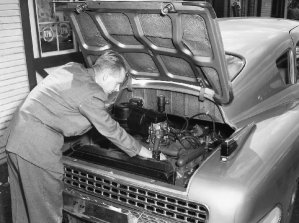
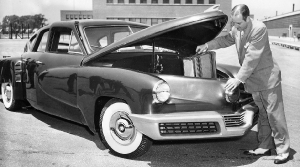
2. It had three headlights. The two outside lights were normal lights like any other car. The middle headlight, or “cyclops,” could change direction.
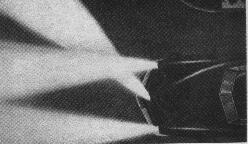
3. It had pop out front windshields. In case of a crash, the glass could come out in two pieces to prevent it from breaking all over the passengers.

4. Its radio system was unparalled.

5. In addition, there were disc brakes, an air cooled engine, interchangeable seats.
Horizontally opposed rear-mounted flat six cylinder engine
Aluminum block produced by Franklin Aircooled Motors
Maximum horsepower: 166 b.h.p. @ 3200 r.p.m.
Maximum torque: 450 lbs/ft @ 1800 r.p.m.
Induction system: 2-bbl. Stromberg downdraft carburetor, mechanical fuel pump
Exhaust system: Twin mufflers, 6 exhaust pipes
Electrical system: 6-volt battery/coil
Fuel feed: Direct fuel injection through rotating distributor pump; S-2 single plunger or S-3 multiple plunger systems. Pressure at nozzle; 100 to 200 p.s.i.
Operating oil pressure: 60 p.s.i.
Ignition: 12-volt system, Autolite distributor and low output coil
Weight (complete): 490 lbs.
Transmission: 4-speed manual with Bendix vacuum-electrical preselector
Brakes: 4-wheel hydraulic drums, internal expanding
General Specifications:
Wheelbase: 130 in.
Front tread: 64 in.
Rear tread: 65 in.
Tire size: 7.00 x 15.00
Height: 60 in.
Length: 219 in.
Width: 79 in.
Weight: 4235 lbs.
Fuel Tank: 20 gal.
Mileage: 18-19 m.p.g. average
Original price: $2450 (projected, 1948)
Performance (from Mechanix Illustrated, Aug. 1948)
0-30 m.p.h. 3.5 sec.
0-60 m.p.h. 10.0 sec.
Top speed 119 m.p.h. at Sebring, 1956
Original Tucker Paint Colors
100 Black
200 Walz Blue
300 Dark Green
400 Beige/Tan
500 Silver (Pearl) Gray
600 Maroon
The word of mouth on the Tucker began to spread before one car had been built. To build his car of the future, Tucker obtained the rights to the old Dodge Plant on Cicero in Chicago. It was to be the world’s largest automobile plant. He originally hired 1900 employees to build his fleet. To raise money for his corporation and manufacturing of the first set of cars, Tucker used three ways to raise capital. Suspicion about all three would lead to his down fall.
1. Tucker sold licenses to 2000 dealers across the country.
2. Tucker began selling stock in his company. Over 10,000 such certificates were issued.
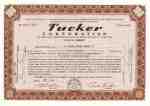
3. Tucker also began selling accessories to the car.

Over $25 million in capital was raised. This amount of money turned many heads in the automobile industry. Small start up car companies at that point in history relied on grants. For an upstart company like Tucker, the capital raised almost insured its success. However, the amount raised caught the ire of the Securities and Exchange Commission (SEC). They soon filed a suit which bring about the downfall of the company because the assets were frozen. The company could do nothing. Tucker and six of his executives were indicted on 25 counts of fraud. To try and quell speculation regarding the trial, Tucker wrote this letter to the public to keep faith in the company.
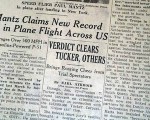 No real evidence was put forth by the SEC and Otto Kerner that the Tucker Corporation was misusing the capital it had raised. Every prosecutory piece of evidence had been rebuked under cross examination. When it came time to give the defense, Tucker’s attorney, William Kirby, offered no defense. The six defendants and Tucker were all acquitted.
No real evidence was put forth by the SEC and Otto Kerner that the Tucker Corporation was misusing the capital it had raised. Every prosecutory piece of evidence had been rebuked under cross examination. When it came time to give the defense, Tucker’s attorney, William Kirby, offered no defense. The six defendants and Tucker were all acquitted.
It was too late for the company though. The Tucker Car Company was over. The lawsuit had driven the company under. Only 51 cars were produced. 47 are still in existence. The Tucker Car Club of America has pictures and details about every single car produced.
Tucker would go to Brazil to build a car known as the Carioca. However, Tucker died of lung cancer in 1956. The Tucker ’48 sedans still live on for only a few people. The remaining cars today are valued at upwards of 200,000 a piece.Several of the design and safety features of the Tucker would make their way into car design in the 1950s.
The tragedy for Tucker was that the lawsuit by the SEC brought down his company before it could even compete with the Ford, GM, or Chrysler. Speculation exists that pressure was put on the SEC by Michigan Congressman to bring down Tucker. Economist Melvin Barger disagrees. He believes Tucker was doomed from the start.
Tucker himself, if he had possessed more self-understanding and business savvy, might have prospered as a custom car remodeler. He did have a love of cars and he had experience in the automotive field. In a way, the Tucker car itself was a customized remodeling of existing car concepts. Tucker’s use of the Cord trans-mission, for example, showed that he understood nifty innovations which somehow hadn’t succeeded in the market. But one of Tucker’s problems was in being carried away by a “dream” while ignoring the practical work needed to apply it for useful purposes. Mere possession of a dream does not excuse a person from exercising prudence in business relationships.
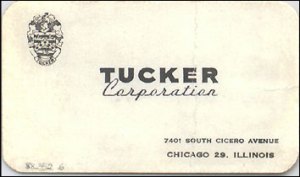

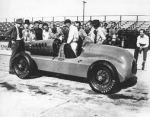
[…] for other areas of the industry in order to help develop and create the next level of technology. The Tucker 48 was originally thought to be the “Car of Tomorrow” as one of the most advanced vehicles ever […]